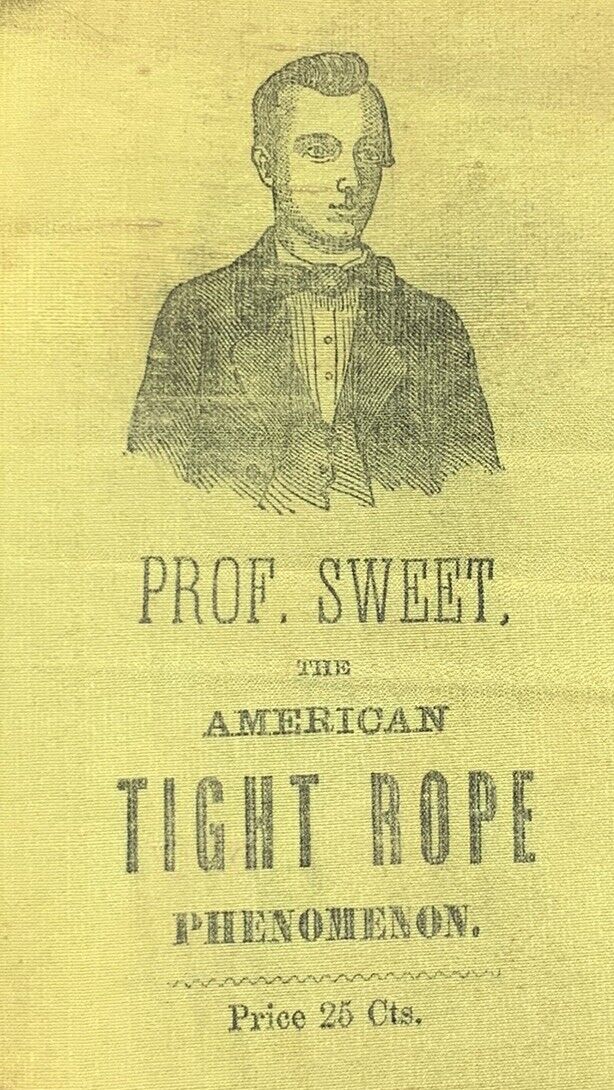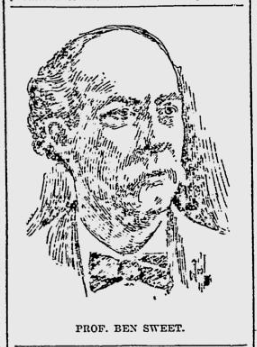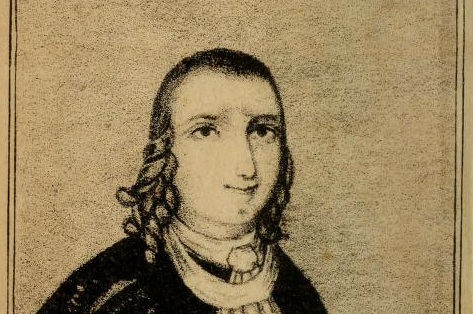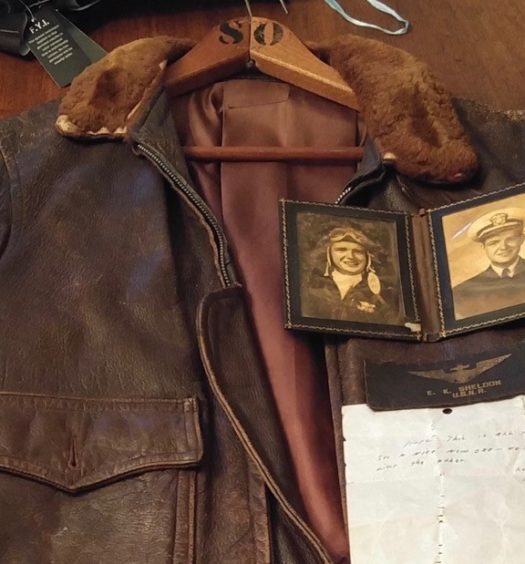In the 19th century Rhode Island was the home of two daredevils who achieved fame for their bold acts of daring. The first was Sam Patch who became nationally known as a jumper from staggering water fall heights into rivers below. Patch’s fame was such that President Andrew Jackson named his horse Sam Patch. The other daredevil was Benoni Sweet who styled himself as “Professor Benoni Sweet” and received regional acclaim for his feats of death-defying acts on a tight rope. A prior article in this two-part series addressed Sam Patch’s career. This article focuses on Benoni Sweet.
Thirty years after the tragic death of Sam Patch in 1829, Benoni Sweet made his first appearance as a funambulist in Rhode Island. Sweet was born on March 16, 1840, at Phenix (a village in what is present day West Warwick), the son of Benjamin and Susannah (Reynolds).
As a young man he learned the printing trade at the Kent County Atlas located in Phenix. How he learned he had a calling as a tight rope performer is unknown, but at just 19 years old he was performing feats of danger in his hometown and soon thereafter he was performing in Providence, Pawtucket (over the Seekonk River), Warren, Woonsocket (over the falls of the Blackstone River), and in nearby Connecticut.
How did Sweet learn to right rope walk? Did an expert performer travel through Rhode Island and teach Sweet the ins-and-outs? Or did Sweet read about such performers in a newspaper or magazine and decide to teach himself to tight rope walk? Sweet never said publicly. In any event, he spent hundreds of hours practicing tight rope walking, eventually become an expert.
The earliest record of Sweet’s tight rope exhibitions took place in his hometown in September 1859 as he walked across the Pawtuxet River. Unfortunately, the rope snapped, and he fell into the river. Fortunately, he escaped without injury.
Undaunted by his brush with death, the following week he was in Norwich, Connecticut, where he walked across the Shetucket River from a rope stretched from Apollo Hall to a hill on the opposite side of the river. At the midpoint of his crossing, he stopped and stood on his head. According to the October 6, 1859, edition of the Manufacturers and Farmer’s Journal, Sweet then “performed a great variety of palliptians, classical poses, and pancratical attitudes too numerous to mention.” Sweet proved he was a spectacular performer, which opened up more doors for him to display his new skill.
Sweet famously displayed his remarkable ability at a multi-day “Great Tight Rope Carnival” over Silver Lake in Providence in mid-October 1859. (Silver Lake was located between Dayer Avenue and Plainfield Street; the lake was eventually drained and house lots were plotted in its place. This section of Providence is still referred to as Silver Lake.) Widespread advertising led to a well-attended event. Sweet performed three times a day with the first walk beginning at 10 a.m. Each walk varied somewhat from the others (no doubt Sweet sought repeat attendees). In one crossing on the tight rope, fifty feet above the lake, Sweet’s head and shoulders were covered with a sack as he crossed the 600-foot length to the opposite shore. On another crossing he returned walking backwards. On his last walk of the day, he carried a stove and at the halfway point stopped, cooked a beef steak, and ate it while drawing up a cup of water to drink from the lake below.
With the throngs of crowds, someone had to make a profit. The event was sponsored by Providence real estate broker S.A. Nightingale who contracted with Sweet in order to draw a crowd for his auctions. After each of Sweet’s crossings, platted house lots on either shore of the lake were sold off at auction to the highest bidders. Sweet was compensated $350 for the first day of the carnival, $150 for the second day and $100 for the final day. One newspaper account reported that all of the lots were sold at “satisfactory prices.”
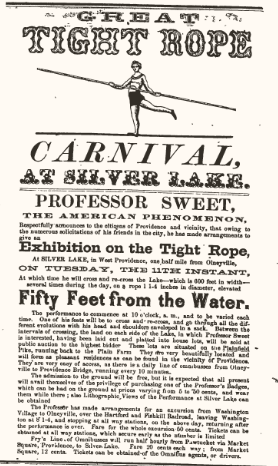
Advertisement for Benoni Sweet tightrope walking event in the Rhode Island Pendulum, October 8, 1959
Admission to the exhibitions was free of charge but as noted in the advertisements it was expected that those attending would purchase a badge to be worn. The cost of badges varied in price from five to fifty cents. Also available for sale that day were lithographic views of Sweet’s performance. Whatever income realized from the sale of badges and lithographs, when added to the $600 Sweet got from Nightingale, it was a considerable amount of money for three days’ worth of work for 1859. Then again Sweet did put his life on the line for his big payday.
The year following his debut as a daredevil, Sweet was married on January 19, 1860, to Susan Colwell of Cranston. The newspaper announcement of the marriage referred to him as Professor Benoni Sweet.
The title of Professor may have been intended to distinguish him from another Benoni Sweet in Rhode Island. Dr. Benoni Sweet, born in South Kingstown in 1840, came from a family that gained renown over generations for practicing the unique skill of setting broken bones (called bonesetting). Dr. Sweet too reached some acclaim for his ability to set broken bones.
In 1861, with the outbreak of the Civil War, Sweet enlisted in the Union army. On July 4, Independence Day, just weeks before the disastrous battle at Bull Run, Rhode Island military units were encamped near Washington, D.C. at Camp Clark. Sergeant Elisha Hunt Rhodes noted in his diary, “Prof. Benoni Sweet, a member of Company H, Second Rhode Island gave an exhibition of tight rope walking.” (See Robert Hunt Rhodes, ed., All for the Union, The Civil War Diary and Letters of Elisha Hunt Rhodes (New York, 1991), page 13).
In August 1861, Sweet walked across Pennsylvania Avenue from the National Hotel to the Clarendon Hotel. The walk was witnessed by President Abraham Lincoln and his wife, Mary. Appreciating the welcome distraction from war, Lincoln reportedly presented Sweet with a gold dollar.
In 1862, while encamped at Camp Brightwood, Sweet once again took to the tight rope, this time in celebration of George Washington’s birthday on February 22. In addition to camp events to mark the day, according to Rhode Island army chaplain Augustus Woodbury, soldiers participated in target-shooting, footraces, and sack-races. He added, “Corporal Sweet swung a tight-rope, and went through various bewildering evolutions upon it, with a wheelbarrow and camp stove.”
In 1864 Sweet was seriously wounded in his neck during the brutal siege of Petersburg, south of Richmond in Virginia. Happily, in due course he recovered and in June 1865 with the war now over he was promoted to sergeant major. He performed one last time for the Second Rhode Island Regiment, at its Independence Day celebration as the regiment waited to be mustered out of service. Sergeant-major Sweet, according to Woodbury, “delighted an admiring multitude with his famous ‘pancratical’ feats and performances.” (The prior two quotes are from Augustus Woodbury, The Second Rhode Island Regiment: A Narrative of Military Operations (Providence, 1875), pages 63 and 364).
Sweet tried to earn some money immediately after the war by performing on a tight rope. In August 1865, less than one month after his discharge from military duty, it was announced that he had equipped himself with new ropes and appurtenances and would be spending the next three months giving exhibitions in various New England towns. The first exhibition, as advertised in the August 7, 1865, edition of Providence’s Manufactures and Farmer’s Journal was to be on Saturday at Read’s Saloon in East Greenwich. But Sweet likely found it difficult to earn a living by performing.
Sweet had to find more permanent employment, which he did once again in the printing business. He eventually was hired by the What Cheer Printing Company in Providence. On December 11, 1869, he was initiated into the Providence Typographical Union, Local 33. By the beginning of the 20th century, he was known as “Sweet, the Printer” at 862 Broad Street.
While Sweet was a printer, his passion was entertaining as a tight rope walker. But Sweet’s performances were not all without mishap. In July 1868, while performing in Warren, someone in the crowd pulled the arm of one of the men holding a guy wire causing Sweet to fall thirty feet to the street below. Sweet survived but the fall seriously injured his arm and a leg.
Sweet broadened his performance horizons by making bets based on his performance at unusual events. In 1867 he made a wager to walk a hundred miles in twenty-four hours (on the ground, not on a tight rope). The Worcester Daily Spy, in its January 2, 1868 edition, noted, “Prof. Benoni Sweet, equipped in a cardigan jacket, knee-breeches, classic gaiters, spangled belt and garters, little white hat, and light switch in his fist, kept walking from Providence to Phenix and back again, to and fro, all day on Tuesday.…. Though the roads were frozen into countless angles of hard mud he accomplished 50 miles in 12 hours, after which he lay down to rest, and his legs became so stiff as to prevent his taking the road again.”
Despite losing the bet, in 1869 he offered to wager $10,000 against $5,000 that he could ride a velocipede of his own contrivance three thousand miles in thirty-seven days. It is not known if anyone took him up on the bet. He even experimented with a pair of water waking shoes that he called his “little gunboats.” For a time, he formed a troupe of minstrels and toured the country. It seems Sweet was a born showman.
In 1875 Sweet gave up tight rope performances following his July 4th show at George’s Park in Wrentham, Massachusetts. He married for a second time in December 1875, this time to Harriett R. Corp of Providence. Presumably, his family and day job took up too much of his time to continue performing. But by the mid-1890s he reprised his tight rope performances. Thirty-five years after his inaugural performance he was again the featured act for a Fourth of July show in his native community of Phenix.
Now 54 years old Sweet was determined to demonstrate he had not lost any of his skills. He set himself up at the Briggs Hotel days ahead of time to discuss his walk with the citizens of the area. A newspaper report in the July 5, 1894, edition of the Providence Journal described the scene:
Shortly after 5 o’clock the Professor, attired in acrobatic costume, and wearing the badge of the Second Rhode Island Veteran Association, and carrying an American flag, left the Briggs House, and entered a barouche driven by William R. Snell, who performed a similar office for the Professor on the occasion of his first public appearance, at Phenix, in 1859. The same footman who accompanied coachman Snell, and Joe Atwood, who also accompanied the party, as groom, in ‘59, and Mrs. Sweet, were also occupants of the barouche which was escorted by the Phenix Band. Promptly at 6 o’clock the Professor began to climb the rope, and was soon, pole in hand, making his way across the stream, amid the encouraging plaudits of the assembled thousands, many of whom had seen his original performance. On arriving at the middle of the stream he did the ‘drop act,’ walked backwards and assumed several of his old attitudes. The rope was crossed, and the return journey made without mishap, and when the performance was over and the Professor re-entered the barouche to return to the hotel, he was given an ovation as he was driven through the crowded streets to the Briggs House, where he held a reception during the remainder of the evening.
During the reception Sweet promised to return in six years to celebrate the new century by walking across the South Branch of the Pawtuxet River at Jericho. (Jericho was a section of the town that today is part of Arctic in West Warwick.) If he did in fact return six years later, it is unrecorded.
Benoni Sweet died February 16, 1913. The Bristol Phoenix newspaper probably said it best when reporting on Sweet’s tight rope walk in Woonsocket in December 1859: “The Professor has become a decided Rhode Island Institution.”
Benoni Sweet’s accomplishments are today all but forgotten, yet he was willing to put his life on the line for public acclaim and some small amount of money (in common with Sam Patch). The remains of Professor Sweet are located in the Greenwood Cemetery in Coventry. His gravestone has no markings to indicate his daredevil exploits and only notes his role in the Union Army.



